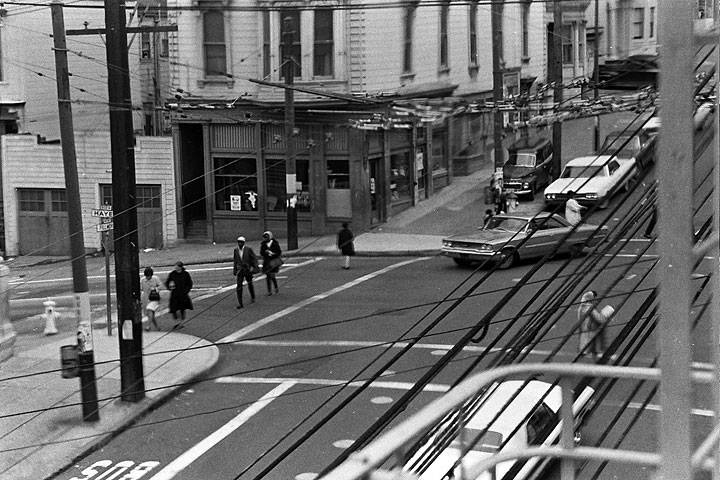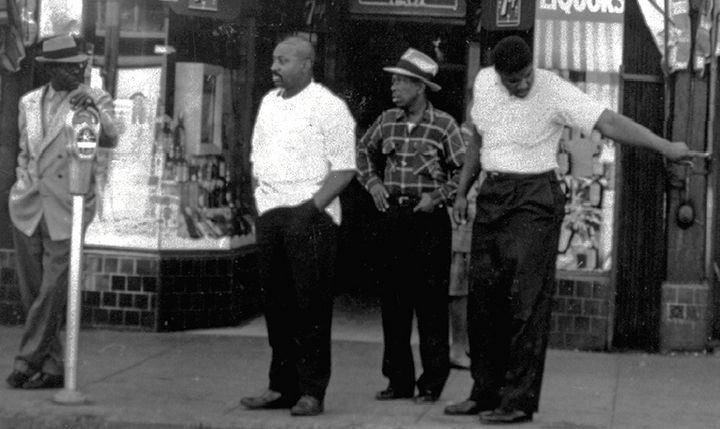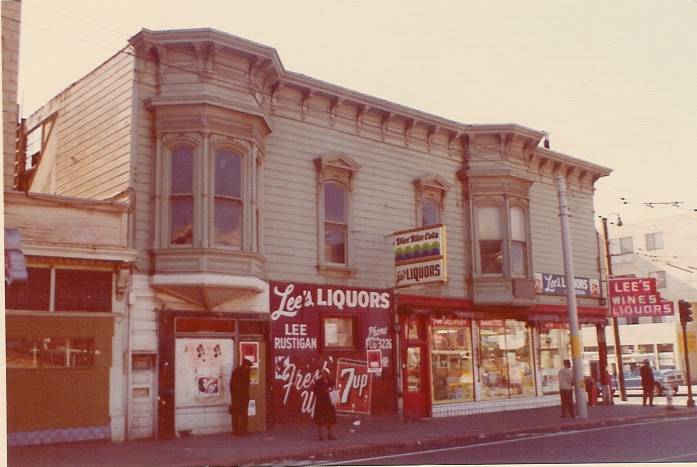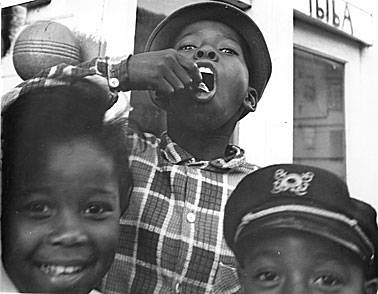Fillmore Street 1960: Difference between revisions
put in photo from our unused collection |
updated video link |
||
| (8 intermediate revisions by the same user not shown) | |||
| Line 1: | Line 1: | ||
'''<font face = arial light> <font color = maroon> <font size = 3>Unfinished History</font></font> </font>''' | '''<font face = arial light> <font color = maroon> <font size = 3>Unfinished History</font></font> </font>''' | ||
[[Image:westaddi$fillmore-st-1960s-photo.jpg]] | <iframe width="560" height="315" src="https://www.youtube.com/embed/Hy9z_Jo8Du0?si=nDGkKyvUptOHJCbC" title="YouTube video player" frameborder="0" allow="accelerometer; autoplay; clipboard-write; encrypted-media; gyroscope; picture-in-picture; web-share" referrerpolicy="strict-origin-when-cross-origin" allowfullscreen></iframe> | ||
<font size=4>Take This Hammer, part 1</font size> | |||
'''KQED's mobile film unit follows author and activist James Baldwin in the spring of 1963, as he's driven around San Francisco to meet with members of the local African-American community.''' He is escorted by Youth For Service's Executive Director Orville Luster and intent on discovering: "The real situation of Negroes in the city, as opposed to the image San Francisco would like to present." He declares: "There is no moral distance ... between the facts of life in San Francisco and the facts of life in Birmingham. Someone's got to tell it like it is. And that's where it's at." Includes frank exchanges with local people on the street, meetings with community leaders and extended point-of-view sequences shot from a moving vehicle, featuring the Bayview and Western Addition neighborhoods. Baldwin reflects on the racial inequality that African-Americans are forced to confront and at one point tries to lift the morale of a young man by expressing his conviction that: "There will be a Negro president of this country but it will not be the country that we are sitting in now." | |||
[[Image:Hayes-and-fillmore 0796-1 Chuck-Gould.jpg]] | |||
'''Hayes and Fillmore, c. 1966.''' | |||
''Photo: © Chuck Gould, all rights reserved.'' | |||
[[Image:westaddi$fillmore-st-1960s-photo.jpg|720px]] | |||
'''Another day on Fillmore Street, during its peak as an [[The Fillmore: Black SF | African-American neighborhood]], c. 1960''' <br>''Photo: African American Historical and Cultural Society, San Francisco, CA '' | '''Another day on Fillmore Street, during its peak as an [[The Fillmore: Black SF | African-American neighborhood]], c. 1960''' <br>''Photo: African American Historical and Cultural Society, San Francisco, CA '' | ||
| Line 15: | Line 27: | ||
'''Three kids enjoying cotton candy at [[Playland|Playland at the Beach]], mid-1960s'''<br>''Photo: Kurt Bank'' | '''Three kids enjoying cotton candy at [[Playland|Playland at the Beach]], mid-1960s'''<br>''Photo: Kurt Bank'' | ||
[[Fillmore Arches Torn Down |Prev. Document]] [[ | [[Fillmore Arches Torn Down |Prev. Document]] [[Western Addition Early 20th Century Life and Work |Next Document]] | ||
[[category:Western Addition]] [[category:1960s]] [[category:African-American]] | [[category:Western Addition]] [[category:1960s]] [[category:African-American]] | ||
Latest revision as of 13:36, 14 September 2024
Unfinished History
Take This Hammer, part 1
KQED's mobile film unit follows author and activist James Baldwin in the spring of 1963, as he's driven around San Francisco to meet with members of the local African-American community. He is escorted by Youth For Service's Executive Director Orville Luster and intent on discovering: "The real situation of Negroes in the city, as opposed to the image San Francisco would like to present." He declares: "There is no moral distance ... between the facts of life in San Francisco and the facts of life in Birmingham. Someone's got to tell it like it is. And that's where it's at." Includes frank exchanges with local people on the street, meetings with community leaders and extended point-of-view sequences shot from a moving vehicle, featuring the Bayview and Western Addition neighborhoods. Baldwin reflects on the racial inequality that African-Americans are forced to confront and at one point tries to lift the morale of a young man by expressing his conviction that: "There will be a Negro president of this country but it will not be the country that we are sitting in now."
Hayes and Fillmore, c. 1966.
Photo: © Chuck Gould, all rights reserved.
Another day on Fillmore Street, during its peak as an African-American neighborhood, c. 1960
Photo: African American Historical and Cultural Society, San Francisco, CA
Lee's Liquor Store at 1656-58 Fillmore Street, between Geary and Post, in early 1960s before Redevelopment bulldozed this block.
Photo: SFNative
Three kids enjoying cotton candy at Playland at the Beach, mid-1960s
Photo: Kurt Bank




